HOW MANY TIMES HAVE YOU NOTICED the line of weeds out of the corner of your eye and driven past, around, or through it without a second glance on your way to a dive? In our case, most of the time.
On a calm day off Jupiter, Florida, a wide weed line at the edge of the Gulf Stream seduced David Doubilet and me to look, stop, and roll in on snorkel. At first we saw nothing and then more nothing before our eyes adjusted to see shapes and slight movement. We realized we were looking at a marine nursery full of small, nearly unidentifiable versions of things we know as adults. There were juvenile swordfish, jacks, and nudibranchs, more unidentifiable creatures than identifiable. We had been going to see goliath groupers, so we had the absolute wrong complement of cameras for these juveniles.
That night David and I talked about how the canopy had quickly produced a long list of quirky creatures that elicited reactions such as, “What is that?” “That can’t possibly be what I think it is!” “Is that triggerfish going to take my ear off?” “Hey, was that a turtle hatchling?” The short snorkel dip became the catalyst for research that became a proposal to National Geographic magazine and a story on sargassum for which both the subject and the coverage expanded exponentially.
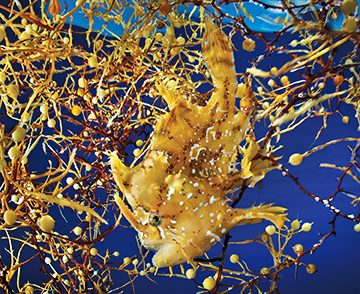
The Seaweed
Sargassum is a floating, golden-brown macroalgae with pearl-sized air bladders that resemble grapes buoying thick leaves. Wind and waves weave together the leaves to form large, nearly impenetrable mats, creating an ephemeral ceiling on the sea that may be there one day and gone the next. The living tapestries can range in size from no bigger than your cellphone to miles wide. No matter their size, they have nooks, crannies, compartments, and shadows that are valuable real estate in the open ocean for both hunters and the hunted.
Sargassum is sometimes called gulfweed or sea holly because of the berry-sized bladders. I can confirm that swimming through the canopy feels like swimming through your grandmother’s prized prickly holly bush. David likens it to swimming through a box of rubber bands — one stroke forward only to be pulled two strokes back, untangle the camera strobes, swear, and proceed again.
Sargasso Sea
Sargassum production centers lie within the Gulf of Mexico and the Northwest Atlantic, with the largest concentrations in the Sargasso Sea. Recalling the legends and lore of losses inside the Bermuda Triangle and tales of schooners stuck in weeds so thick it was as if they were at anchor, we predictably began the story in the Sargasso Sea.
It is a mid-Atlantic world without a border or continental coastline, bounded instead by currents that make up the North Atlantic Gyre. These invisible borders encircle an ecosystem like no other. The sargassum is its defining feature and namesake. The two species growing here, Sargassum natans dan Sargassum fluitans, are holopelagic, which is a fancy word for the weeds growing and reproducing vegetatively without touching the seafloor.
The seaweed canopy is a superb, tangled jungle of leaves that is a constantly shifting shelter for countless marine species at their most vulnerable stages and the bigger things that show up to eat them. But its other contribution is invisible: The seaweed sequesters carbon. If the seaweed sinks to the ocean floor, the carbon component is captured; if the weed is consumed and digested or washes ashore and decomposes, the carbon is released back into the carbon cycle. Sargassum is not as efficient as mangroves or seagrass at locking up carbon but is still a major contributor to removing atmospheric carbon dioxide.
With time we learned to find nudibranchs, shrimps, crabs, and the tiny tiger in the tangles: the sargassum fish, an ambush predator with an insatiable appetite and well-adapted fins that resemble feet.
The best parts of any story, especially this story, were not just the discoveries, natural history, and climate. They were also the science, collaborations, friendships new and renewed, history, life, death, learning, and ocean storytelling in a time defined by rapidly changing conditions that forced us to face hard truths about climate change in our oceans. This story taught us to stop and explore parts of the sea that we often pass by on the way to somewhere more exotic and exciting.
Panduan National Geographic assignment began in Bermuda, an island country located like a research ship at sail in the center of the Sargasso Sea. The plan was to explore the canopy and what lies within and beneath it, collaborating with renowned Bermudian Teddy Tucker at the helm of the project and our boat. Photographers David Doubilet and David Liittschwager, writer James Prosek, and I completed the storytelling team. Teddy was Bermuda’s preeminent explorer, shipwreck finder, historian, naturalist, and national treasure. The Sargasso Sea was his front and backyard his entire life. Philippe Rouja, Ph.D., the Bermuda custodian of historic wrecks and all-around ocean being, along with his brother, Jean-Pierre, and marine biologist Chris Flook completed our motley crew.
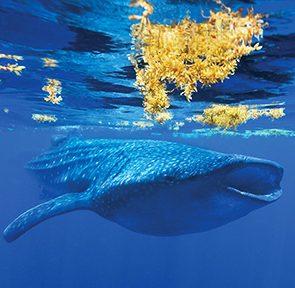
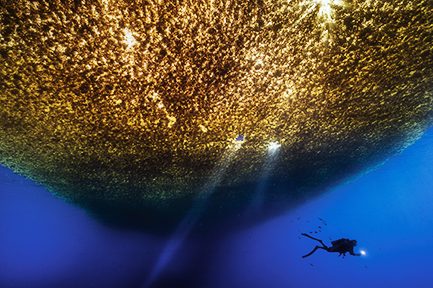
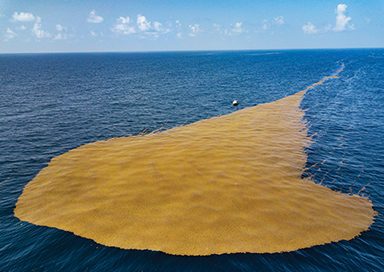
We left the concrete dock at dusk in Teddy’s boat, Sea Foam — a marine museum itself, laden with layers of history. We rounded King’s Point and headed for Challenger Bank. Teddy dropped anchor on the seamount, and as he predicted, the boat found the current and drifted back to float over 3,600 feet of water.
We lowered our 1,200-watt hydrargyrum medium-arc iodide (HMI) light into the Sargasso Sea and waited. Teddy captivated us with stories about shipwrecks, treasures lost and found, and his two-person expeditions with Jaws author Peter Benchley to look for the giant squid lurking in the trenches below. It was a magical moment on the boat deck in the dark, listening to the history of the surrounding sea delivered in a melodic rasp from the historian himself.
He brought us back to reality with, “We have a customer,” and just like that, a blue marlin swung beneath our boat to check out the light. It flashed brilliant colors before disappearing into the night, leaving behind bearded flying fish at the edge of golden floating weeds. We strapped David into a harness and deployed him like an anchor equipped with a camera.
While the boat was anchored, a conveyor belt of sargassum passed by, illuminated in the dark sea like a Broadway stage. Flying fish circled in front of David, flashing their colorful fins that spread and found air, sending the fish skittering across the surface. We were effectively trolling in place with David as bait. That became apparent when a cheeky tiger shark made his way undetected under the weeds alongside the dinghy downstream of David and right at the light’s edge. A break in the weeds exposed his unmistakable stripes. Philippe gave a tremendous yank on David’s harness to announce the oversize visitor.
We thought that the story would begin and end off Bermuda’s shores and that we would have long, luxurious days and nights with Teddy on the back of his boat, sharing stories until we had our own for the magazine. Neither would turn out to be true. Teddy died June 9, 2014, on his dock while preparing the boat for our second season. His beloved wife, Edna, a wonderful force of nature, called us after his burial and said, “Where are you? Don’t dally. The story is waiting, and Teddy is still at the helm. You’ll feel him; you just won’t see him.”
We rounded King’s Point again, feeling Teddy’s spirit on the wind. Chris scouted rafts of weeds from his boat, and we plunged into a golden world. Exploring the canopy was like exploring the plains of an upside-down Serengeti. Predators roamed the fringes looking for a meal, ocean triggerfish plundered the weeds hoping for an edible discovery, and we were stopped in our tracks with wonder at the appearance of the elusive Atlantic tripletail. The tripletail is so adapted for the weed that it would disappear and reappear like moving brush strokes in a magical painting from a Harry Potter movie.
We adjusted our eyes to find the smaller, well-camouflaged residents we knew lived in the canopy. With time we learned to find nudibranchs, shrimps, crabs, and the tiny tiger in the tangles: the sargassum fish, an ambush predator with an insatiable appetite and well-adapted fins that resemble feet. Liittschwager collected a soccer-ball-sized clump of weed in a bucket of water and took it back to his bathroom studio to rapidly identify and photograph Lilliputian life forms. He counted and photographed about 3,000 creatures barely visible to his naked eye.
As our Bermuda operations continued, nature conspired to change our story. The coverage’s scope, size, and scale grew in parallel with the explosive growth of sargassum that began to appear off South America, the Caribbean, and in the Gulf of Mexico. The ultimate cause of the blooms remains to be scientifically agreed upon: shifting currents, dust from droughts in North Africa, nutrients pouring out of the Orinoco River in South America, or nutrient enrichment from industrial farming and Atlantic upwelling. Whatever the cause, it is the perfect recipe for an explosive bloom of algae that enters the Caribbean in unfathomable amounts. The wind drives parallel rafts of weeds the size of aircraft carriers across the Caribbean basin like World War II assault fleets.
The weed masses are a productive utopia of life at sea, with sea turtles and larval sea life embraced within its branches and on the menu for predators. But plenty of a good thing at sea can be too much when it reaches the shore — in fact, it becomes a bad thing. Large rafts driven onto windward island beaches and slammed into the Yucatán Peninsula were anything but utopias. Bays became choked overnight, trapping fishing boats; billion-dollar beaches became inundated with dying, fermenting weeds smelling of sulfur, and costs to remove the weeds soared into the millions. Once ashore, the once viable sargassum habitat became a deadly blanket, smothering countless sea turtle and shorebird nests and demolishing tourism.
In 2015 reports of Caribbean islands buried under weeds began to pour in again. To learn about and locate the episodic inundations, we reached out to some seaweed experts: Brian Lapointe, Ph.D., of Florida Atlantic University’s Harbor Branch Oceanographic Institute; Jim Franks, M.S., of the University of Southern Mississippi’s Gulf Coast Research Laboratory; Chuanmin Hu, Ph.D., of the University of South Florida; Hazel Oxenford, Ph.D., of the University of West Indies; the Sargasso Sea Commission; and the Mexico Department of Environment in Cancun.
We plugged into sargassum satellite sites that monitored and predicted landings across the Caribbean and spoke to islanders, governments, scientists, and fishers from Guadalupe to Mexico. The consensus was clear: Go to the Yucatán Peninsula, the last stop on the Caribbean conveyor belt. The beaches there are a catcher’s mitt for sargassum.
I called the Department of Environment in Cancun on a Friday afternoon in August and asked an official about sargassum and where to find it. He said that it was piled onshore with much more coming. Without hanging up, he connected us with Fernando Gonzales as a guide if David and I could catch a flight the next morning. I told him that I couldn’t make it there, but David could.
An environmental official picked up David in Cancun the following day and took him to Akumal, where seaweed had buried the beaches. David took the ferry to Cozumel to meet Fernando. They went to sea and encountered large sargassum mats drifting between Cozumel and Riviera Maya. They discovered several sea turtle hatchlings hiding in the branches as they explored the canopy.
David’s excitement was instantly followed by trepidation as he wondered what would happen to these turtles when the seaweed hit the shore. The two divers descended beneath the huge, shadowy cathedral. Their rising bubbles created openings in the canopy that let shafts of light pierce the sea below. It was a completely unexpected universe.
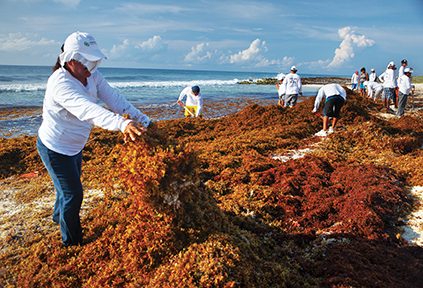
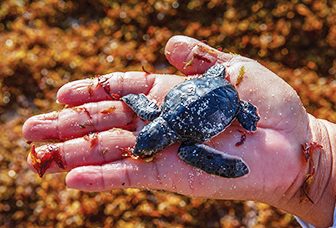
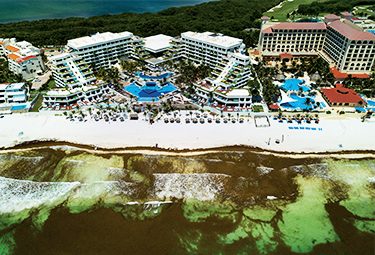
On his last day, David went to Cozumel’s easternmost beaches. Dozens of hired workers removed sargassum using rakes, forks, and their hands. It was there that he discovered the fate of sea turtle hatchlings. Workers exposed smothered hatchlings who had been unable to exit their nests and others buried in the incoming weed.
An even bigger sargassum event happened in 2018, so David and I returned to Mexico, knowing what was once considered episodic inundation was now becoming the new normal. We met dive operators Chris and Pancha, who saw our amount of gear and secured a larger SUV. We drove south through the night to Xcalak, and I was asleep in the back seat when we arrived. I awakened and opened the door to a knock-me-down overwhelming stench of hydrogen sulfide from decaying weeds — a stench beyond any I remember from the farm where I grew up. On a positive note, diver Santiago “Santi” Zurbia, who would assist us, warmly greeted us.
Our team explored the state of sargassum along the Yucatán Peninsula and made our way to Isla Mujeres. Capt. Rodrigo Friscione put us in front of the incoming rafts of weeds. From sea level, their size was too large to estimate. Santi’s drone produced an aerial perspective of our boat looking like a peanut alongside one of the many arriving mats bound for the beaches. The dense weeds were an oasis, a movable feast for sea birds above and marine life below. We descended below the forest into blurry schools of fish moving excitedly in their kingdom. I pulled at a piece of weed, and dozens of fish surrounded my hand in hopeful anticipation of a reward.
We followed a weed line toward shore, coming to dozens of boats and screaming snorkelers in the water. It was whale shark season. Wind and current concentrate both plankton and sargassum, and the whale sharks follow the plankton. We found a weed line away from the chaos and in minutes were greeted with a train of whale sharks swimming the line, gracefully dodging the unwanted weeds with mouths agape for plankton.
Beneath the canopy is a strange unearthly world, a marine jungle that materializes like a dream and then is gone. At sea the sargassum is a dream habitat that makes its way to shore to become a nightmare. These massive blooms of weeds are now typical and just one more indicator of climate change. Municipalities with financial means will deploy people, barriers, and boats to control the seaweed. Entrepreneurs are bioprospecting and commercializing seaweed into products. Countries and communities share science, technology, and creative pathways to monetize the sargassum as a resource.
We had started a story in the heart of the Sargasso Sea, but the planet had other plans. Like most of our assignments now, it evolved into an account of climate change. The changing ocean can now support a 5,500-mile-long sargassum raft, a mass that, like our story, grew far beyond where it began.